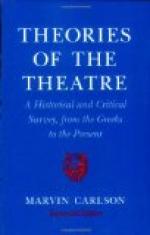But not only must the drama render life more comprehensible by discarding the irrelevant, and attracting attention to the essential; it must also render us the service of bringing to a focus that phase of life it represents. The mirror which the dramatist holds up to nature should be a concave mirror, which concentrates the rays impinging on it to a luminous focal image. Hamlet was too much a metaphysician to busy his mind about the simpler science of physics; but surely this figure of the concave mirror, with its phenomenon of concentration, represents most suggestively his belief concerning the purpose of playing and of plays. The trouble with most of our dramas is that they render scattered and incoherent images of life; they tell us many unimportant things, instead of telling us one important thing in many ways. They reveal but little, because they reproduce too much. But it is only by bringing all life to a focus in a single luminous idea that it is possible, in the two hours’ traffic of the stage, “to show virtue her own feature, scorn her own image, and the very age and body of the time his form and pressure.”
An interesting instance of how a dramatist, by holding, as it were, a concave mirror up to nature, may concentrate all life to a focus in a single luminous idea is afforded by that justly celebrated drama entitled El Gran Galeoto, by Don Jose Echegaray. This play was first produced at the Teatro Espanol on March 19, 1881, and achieved a triumph that soon diffused the fame of its author, which till then had been but local, beyond the Pyrenees. It is now generally recognised as one of the standard monuments of the modern social drama. It owes its eminence mainly to the unflinching emphasis which it casts upon a single great idea. This idea is suggested in its title.
In the old French romance of Launcelot of the Lake, it was Gallehault who first prevailed on Queen Guinevere to give a kiss to Launcelot: he was thus the means of making actual their potential guilty love. His name thereafter, like that of Pandarus of Troy, became a symbol to designate a go-between, inciting to illicit love. In the fifth canto of the Inferno, Francesca da Rimini narrates to Dante how she and Paolo read one day, all unsuspecting, the romance of Launcelot; and after she tells how her lover, allured by the suggestion of the story, kissed her on the mouth all trembling, she adds,




